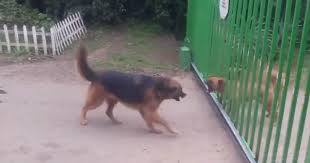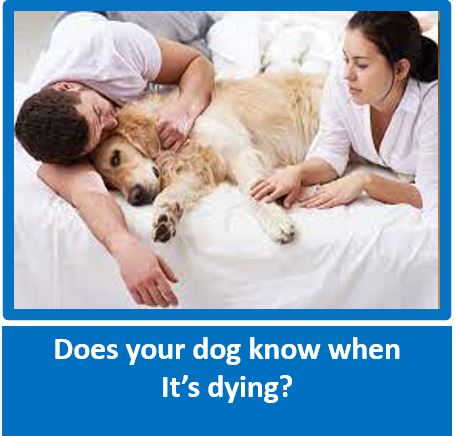
Please visit and LIKE our Facebook Page and share with family, friends and on your own Facebook page, and ask them to share further – it is only by working together and sharing knowledge and education that we can improve the lives of dogs and assist owners. We do not inundate you with posts – an average of 5 per week, and the odd Did You Know. Thank You!
My Dog Attacks Other Dogs at Gates
by Friendsofthedog
by Friendsofthedog

One minute your sweet loving dog is lying relaxing in the sun outside, or playing happily with your other dog, and the next minute he is tearing down to your gate, looking like he is going to kill the dog walking by with his owner - how dare he come near my gate, just not acceptable, I will make sure it does not happen again - the behaviour says!
This behaviour does not only occur at gate - you may have a dog that is inside the house, and a security gate is preventing it going out, or it occurs when the dog is looking at the window - in both these cases, the dog tends to go bananas as another dog walks by.
This is not an uncommon event with dogs, and in dog behaviour terms is known as either barrier aggression or barrier frustration. What is interesting with dogs that behave in this manner, is that often they are totally friendly and socialble with other dogs they meet - not all however!
Why Does This Behaviour Occur?
Very often a combination the factors below could be the reason.
Can this behaviour escalate?
Most certainly yes, and these are some of the things that can occur:-
Management and Prevention
We believe any situation where aggression is in place, that a professional should be called in and below will give you an idea of the work that may be done to change the behaviour.
Changing this Behaviour
We believe that all aggression should be handled by a professional behaviourist, and one with sufficient experience. A trainer is not a behaviourist, and neither is somebody that has done an on-line course over a few months. Becoming a behaviourist involves at least 2 - 4 years of study - understanding dogs - how they think and act, in-depth knowledge of body language, practical experience, understanding of stress, arousal, threshold, triggers that could be contributing towards the behaviour, as well as knowlege of all the modifications that can be used. It is up to the owner to request a copy of the behaviourists qualifications to ensure that they are entrusting their beloved dog to somebody that has the knowledge and experience to change the behaviour and that the behaviourist works only with positive reinforcement methods. Anybody that suggests alpha rolls, jabbing, aversive equipment such as shock collars etc, should be totally avoided. These are the old fashioned methods of working with dogs, and can cause untold long term harm and totally damage your relationship with your dog.
The first thing the behaviourist will do is to determine why the behaviour is actually happening, and that the dogs mental, physical and social needs are being met. They will also examine your overall relationship with the dog and see if any factors in this regard are contributing to the behaviour and show you how to change same.
After the above has been examined and any modifications needed brought in, the behaviourist will probably use a method called counter conditioning. Simply put, counter conditioning involves changing the way a dog feels about something - they are going to change the trigger (the dog on the other side of the gate) with something the dog loves - food, and not just regular old kibble, something delicious such as biltong or liver bread or some other favourite treat - this will change the dogs feelings towards dogs going by the gate.
The owner will probably be given knowledge and tools to be able to call the dog back successfully in the event it does dash towards the gate.
What is important, is that if a dog is engaging in this behaviour, that owners get help as soon as possible - the longer the behaviour is in place, the longer it can take to change, and the more difficult it can be.
This behaviour does not only occur at gate - you may have a dog that is inside the house, and a security gate is preventing it going out, or it occurs when the dog is looking at the window - in both these cases, the dog tends to go bananas as another dog walks by.
This is not an uncommon event with dogs, and in dog behaviour terms is known as either barrier aggression or barrier frustration. What is interesting with dogs that behave in this manner, is that often they are totally friendly and socialble with other dogs they meet - not all however!
Why Does This Behaviour Occur?
Very often a combination the factors below could be the reason.
- Frustration is a common reason - it could be that the normally friendly dog is totally frustrated not being able to go and say hello, however, the behaviour can easily and quickly escalate.
- Frustration and Boredom - the dog may not be receiving sufficient physical, mental or even social interaction. It has found a great way of entertaining itself, although we humans and the dog and owner on the other side of the gate may not find it entertaining!
- Fear - yes fear can be a facotor! Approximately 98% of aggressive behaviour is due to fear, just the behaviour exhibited has gradually increased from perhaps a growl until it looks like a full blown attack taking place. Think about this from a dogs point of view - if I appear big enough, nasty enough, the threat will leave!
- Owner inadvertantly reinforcing the behaviour by shouting, screaming at the dog - remember that to a dog, attention is attention, whether negative or positive!
- Previous experiences. The dog may have been attacked himself when he was out with his own owner, and by exhibiting the aggressive behaviour the dog is trying to ensure it will not happen again - he is behind a gate, so is safe.
Can this behaviour escalate?
Most certainly yes, and these are some of the things that can occur:-
- The behaviour can become more and more extreme. Each and every time this aggressive behaviour occurs it tends to escalate, and again, from a dogs point of view, the perceived threat left, so the behaviour worked and will be repeated.
- There are other dogs in the home and they come down to see what is happening and start to bark and act up as well. The initial dog's arousal levels may get so high that it will exhibit what is called redirected behaviour, and in total frustration will turn on the other dog. This can end up with serious consequences.
- The owner tries to interfere to stop the dog - dog turns on the owner and a bite can ensue - the arousal levels have just gone so high that the dog is reacting, not thinking at all.
- Not all dogs walking by will accept the aggressive behaviour and may react with aggression in return. This increases aggression in both dogs and the liklihood that they will become aggressive to other dogs when out for walks, and even other dogs in the home.
- If it is a small dog on the other side of the gate and it is reacting back and there is a gap in the gate at the bottom, or the bars are set wide apart,the small dog can be pulled under the gate or through the bars - this happens, and mostly when it is one of the fighting dog breeds involved.
- The gate may open unexpectedly! One of two things normally occurs in this situation - either the aggressing dog will run back towards the house, or heavens forbid he will go through the gate and a serious fight ensues. It is not unusual in these circumstances for the owner walking the other dog to be bitten trying to stop the fight - this is a serious and very dangerous situation.
- When engaging in gate aggression, both adrenaline and cortosol are surging through the dogs body and it is in an aroused state and may even be over threshold. Although the behaviour may stop, it does take time for the adreneline and cortisol levels to drop, and there is always the chance that the aggressive behaviour could occur in another situation.
Management and Prevention
- Deny the dog access to the gate - put the dog in another area of the garden where it cannot access the gate.
- Often suggestions are made to put shade cloth or similar against the gate so that the dog cannot see outside. In some instances this will help to prevent the behaviour, however, with some dogs it can actually increase the frustration.
- If a situation where the dog goes nuts when inside but is prevented by going outside by a security gate - either keep the main door closed, put shade cloth or similar over the gate to prevent the dog seeing out.
- If the dog is engaging at the behaviour at a window, keep the dog out of this room, or shut the curtains.
- Ensure that the dog is receiving regular walks and mental stimulation such as safe chew toys, digging pits
We believe any situation where aggression is in place, that a professional should be called in and below will give you an idea of the work that may be done to change the behaviour.
Changing this Behaviour
We believe that all aggression should be handled by a professional behaviourist, and one with sufficient experience. A trainer is not a behaviourist, and neither is somebody that has done an on-line course over a few months. Becoming a behaviourist involves at least 2 - 4 years of study - understanding dogs - how they think and act, in-depth knowledge of body language, practical experience, understanding of stress, arousal, threshold, triggers that could be contributing towards the behaviour, as well as knowlege of all the modifications that can be used. It is up to the owner to request a copy of the behaviourists qualifications to ensure that they are entrusting their beloved dog to somebody that has the knowledge and experience to change the behaviour and that the behaviourist works only with positive reinforcement methods. Anybody that suggests alpha rolls, jabbing, aversive equipment such as shock collars etc, should be totally avoided. These are the old fashioned methods of working with dogs, and can cause untold long term harm and totally damage your relationship with your dog.
The first thing the behaviourist will do is to determine why the behaviour is actually happening, and that the dogs mental, physical and social needs are being met. They will also examine your overall relationship with the dog and see if any factors in this regard are contributing to the behaviour and show you how to change same.
After the above has been examined and any modifications needed brought in, the behaviourist will probably use a method called counter conditioning. Simply put, counter conditioning involves changing the way a dog feels about something - they are going to change the trigger (the dog on the other side of the gate) with something the dog loves - food, and not just regular old kibble, something delicious such as biltong or liver bread or some other favourite treat - this will change the dogs feelings towards dogs going by the gate.
The owner will probably be given knowledge and tools to be able to call the dog back successfully in the event it does dash towards the gate.
What is important, is that if a dog is engaging in this behaviour, that owners get help as soon as possible - the longer the behaviour is in place, the longer it can take to change, and the more difficult it can be.




